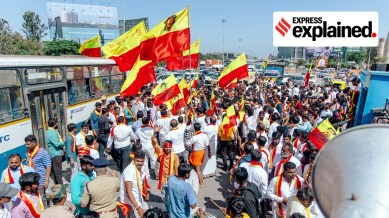Why are pro-Kannada groups protesting signboards in Bengaluru?
A recent order from the civic body of the city mandated that commercial establishments in the city must erect signage in Kannada prominently. How did this spark off protests and what has the state government said?

A Pro-Kannada organisation in Bengaluru engaged in vandalism of various hoardings and billboards on Wednesday (December 27), in a bid to protest the use of the English language in advertisements and signboards.
A faction of the Karnataka Rakshana Vedike (KRV) took out a march from the Sadahalli toll gate towards the city, with simultaneous protests taking place in multiple business hubs. Bengaluru Commissioner of Police B Dayananda said that 10 FIRs had been registered and 53 people were arrested. Among those arrested and sent to judicial custody is KRV president TA Narayana Gowda.
Speaking to The Indian Express, many investors and businessmen raised concerns about the law and order situation and the attacks on businesses and shops. What explains the protests and how has the state government responded?
Why is the use of English on Bengaluru’s hoardings being protested?
The KRV had set Wednesday as a “deadline” for all establishments in Bengaluru to implement a Bruhat Bengaluru Mahanagara Palike (BBMP) order mandating Kannada in signs across the city. Such orders have been issued from time to time.
Recently too, the civic body issued a circular where it said that all commercial establishments in the city must erect signage in Kannada prominently before February 28, 2024. There are 1,400 km of arterial and sub-arterial roads in Bengaluru and all the commercial establishments will be surveyed zone-wise, the BBMP said, adding that notices would be served on those who do not follow the rule.
In 2019, an order based on the civic body’s Outdoor Signage and Public Messaging Bye-Laws of 2018 was issued. The Kannada Development Authority (KDA) had conducted a meeting with the BBMP officials in 2018 and instructed them to cancel the license of the shops that do not have 60 per cent of the nameplates in Kannada. However, the direction was not effectively implemented.
That order was based on the government’s 1986 Sarojini Mahishi report, which said that all nameplates should have Kannada covering 60 per cent of the nameplate, while the rest 40 per cent could be in any other language. The report also recommended that the state should ensure more jobs for Kannadigas in Karnataka. Its suggestions were not implemented either.
What’s behind the demand for pro-Kannada signboards?
The ongoing issue over languages used in signboards has been a long-standing demand of several pro-Kannada organisations. Last week, too, Kannada organisations carried out a procession over the demand at the city’s Chickpet area.
Of late, Pro-Kannada groups have also taken to social media to carry out campaigns on Kannadigas being “sidelined” in the state, as migrants from other parts of the country have come to work there.
Recently, the presence of non-Kannada-speaking staff — especially those from the Hindi heartland — in public sector banks has led to tensions in parts of the state. Some altercations have also been reported between customers and officials over the use of Hindi. Moreover, lists of new employees hired in other PSUs operating from the state have featured only a few locals, adding to the sentiment against migrants.
Claims of ‘Hindi imposition’ in the southern state have aggravated the situation. The KRV has been at the forefront of agitations over such issues, with its motto being ‘Kannada is caste, Kannada is religion and Kannada is god’. It wields political influence in parts of the state, particularly Belagavi.
How has the state government responded?
KRV chief Gowda has claimed that he spoke to Karnataka Chief Minister Siddaramaiah and Deputy Chief Minister D K Shivakumar. “They assured us that the protests would be allowed. If they arrest us or stop movement, then police will be responsible for any unforeseen incidents in Bengaluru,” he said.
Shivakumar, who is also the Bengaluru Development Minister, said, “For those living and doing business in Bengaluru, there is a law which says signages should have 60 per cent Kannada in them. Everyone should follow it.”
A day after the violence, CM Siddaramaiah said his government will bring in an ordinance to ensure that 60 per cent of space on signboards is dedicated to Kannada, with the rest left to other languages.
Siddaramaiah held a meeting with officials of the Kannada and culture department and civic agencies over the issue on Thursday and said, “Kannada is supreme in Karnataka and the government will take all steps to promote the language. In the meantime, we will not allow anyone to take the law into their hands. We will initiate action against them.”
What is the basis of the proposed ordinance?
Citing a circular issued on March 24, 2018, Siddaramiah said, “According to the circular, it was 60 per cent in Kannada and 40 per cent in other languages. However, when the bylaw was amended, it became 50-50. So in the meeting it has been decided to modify it to 60-40 per cent, and I have directed officials to bring in an ordinance.”
He also mentioned the Kannada Language Comprehensive Development Act of 2022. Section 17 talks about “General measures to be taken for extensive use and propagation of Kannada Language.”
Sub-section 17(6) says, “The upper half portion of boards displaying the names of Commercial, Industrial and Business Undertakings, Trusts, Counseling Centre‟s, Hospitals, Laboratories, Amusement Centers and Hotels etc., functioning with the approval and sanction of Government or Local Authorities, shall be in Kannada and lower half can be in any other language.”
Siddaramaiah said, “Today we decided that the signboards and name plates should be 60:40 as per the previous circular. We will bring an amendment to section 17(6) of the said Act, which was introduced by the Kannada and culture department.”